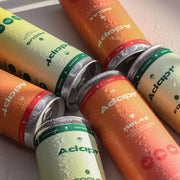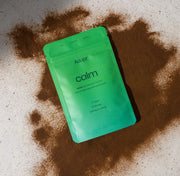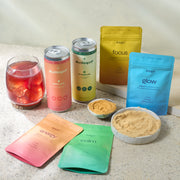Functional mushrooms have always had an air of mystery about them. They’ve found their way out of the forest and onto our kitchen counters, coffee mugs, and supplement shelves - often in the form of mushroom powders or mushroom gummies.
If you’ve wandered down the supplement aisle (or your Instagram feed), you’ve seen both. Brightly coloured gummy bears promising ‘focus’ or ‘immunity’, and earthy brown mushroom powders you have to stir into your drink.
Which is actually better? Let’s dig into the science of how these are made and which works best.
How Functional Mushroom Powders Are Made
Mushroom powders come from real, whole mushrooms.
To make powder, the fruiting body (the cap and stem, what you’d pick in the woods) is harvested, dried at low heat to preserve bioactive compounds like beta-glucans, hericenones, or triterpenes, and then ground into a fine powder.
No added sugar. No filler. Just concentrated mushroom.
Good mushroom powders like Adapt test for their beta-glucan content and often come certified organic. If you’re looking for an authentic experience of the mushroom’s benefits, this is as close as it gets outside of chewing on a raw Lion’s Mane or Reishi.
How Mushroom Gummies Are Made
Mushroom gummies take that powder - or sometimes just an extract of it - and mix it into a syrupy base of sugars, gelatin or pectin, flavourings, colours, and preservatives. Then the mixture is poured into moulds and left to set.
Here’s the catch:
- The amount of mushroom per gummy is often quite low (sometimes less than 250mg per piece, compared to 2000mg in a teaspoon of powder).
- Heat from cooking and processing can degrade the delicate compounds you’re paying for.
They’re convenient, sure. But you’re also getting more sugar, less mushroom.
Efficacy: Powders vs Gummies
The critical factor here is bioactive compound content - the molecules that actually interact with your physiology.
-
Functional mushroom powders, when made from fruiting bodies and properly dried, retain high levels of beta-glucans, which are linked to immune modulation, cognitive support, and stress resilience.
-
Functional mushroom gummies tend to use smaller doses (because you can’t fit much into a bite-sized jelly), and often use lower-quality inputs. Plus, sugars can promote inflammation, which works against what the mushrooms are trying to achieve.
One way to put it: if you want a therapeutic dose, powders make it easy. With gummies, you’d have to eat a whole handful just to approach an effective amount - and even then, the quality may not match.
Are There Any Benefits to Gummies?
They’re portable and they taste good (if you like sweets). If that’s the only way you’ll take your mushrooms consistently, then gummies are better than nothing. If you like the portable nature of gummies, you could also try functional mushroom-infused drinks.
But they’re closer to candy than a serious supplement.
The Downsides of Powders?
They can taste slightly earthy. They’re not quite as convenient if you’re running to catch a train.
But with powders you have control - you can adjust your dose, you know what you’re getting, and you avoid unnecessary sugars and fillers.
Verdict: Mushroom Powders Win
Here’s the truth:
If you’re looking for measurable health benefits; clearer focus, steadier energy, immune support - go for a good, fruiting-body mushroom powder. You can stir it into hot water, coffee or blend it into smoothies.
It might not feel quite as fun as popping a gummy, but it’s more aligned with the science, and your body will thank you for it.
Closing Thoughts
It’s tempting to reach for whatever promises benefits with the least effort - and that’s why gummies have exploded. But supplements are only as good as what’s inside them, and in the case of mushrooms, what’s inside the gummy often isn’t much.
There’s something almost meditative about scooping up a bitter spoonful of powder, knowing it’s closer to the earth, closer to the original organism, closer to the real thing.
If you want the benefits of functional mushrooms, not just the idea of them, reach for the powder.



